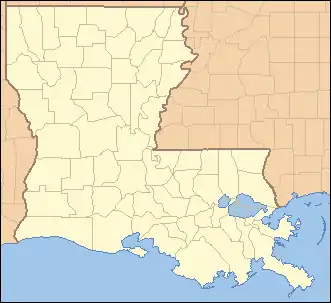 |
| Map of state parks maintained by the Office of State Parks (Each dot is linked to the corresponding park article) |
The state of Louisiana has 21 state parks, which are governed by the Office of Lieutenant Governor, a division of the Louisiana Department of Culture, Recreation and Tourism.[1] Louisiana's state park system began in 1934 when the state passed legislation that created the State Parks Commission of Louisiana.[2] In 1952, legislation broadened the role of the commission to include the development of outdoor recreation programs and resources. The commission was renamed to the Louisiana State Parks and Recreation Commission.[2] In 1977, the Office of State Parks was created in the Department of Culture, Recreation, and Tourism.[2]
After the State Parks Commission of Louisiana was formed in 1934, 7 sites were acquired for use as state parks.[2] During World War II, the rate of new park acquisition declined with the addition of only one new site, Sam Houston Jones State Park in 1944. In 1966, the National Park Service reviewed Louisiana's state parks system and made many recommendations, which led to specific guidelines and requirements for state parks.[3] Over time, many state parks that did not meet these guidelines were either reclassified as state historic sites or were turned over to local or state agencies. Some of these parks include Lac des Allemands, Saline Bayou, and Black Lake.[4] During the 1970s, government management of the state parks was restructured. The Office of State Parks was created, and 2 new parks were acquired. From 1995 to 2009, $80 million were invested in creating new facilities, or updating existing facilities.[2]
Louisiana state parks are selected on the criteria that they must be natural areas of unique or exceptional scenic value.[3] Many of the state parks also have historic or scientific importance. For example, Chemin-A-Haut State Park served as a route used by Native Americans during seasonal migrations.[5] Louisiana state parks have many accommodations, including overnight cabins, boating rentals, guided daily tours, and fishing piers. In 2002, Louisiana state parks had more than 2 million visitors.[2] With the addition of Palmetto Island State Park in 2010, Louisiana state parks comprise more than 30,000 acres (12,000 ha) of land.
Current parks
| Park name | Parish | Size | Year Established | Remarks | Image |
|---|---|---|---|---|---|
| Bayou Segnette State Park | Jefferson Parish | 676 acres (274 ha)[6] | 1987[7] | Bayou Segnette State Park features a wave pool.[8] | 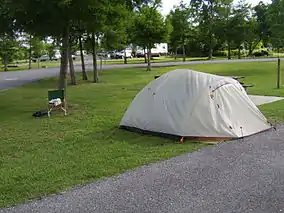 |
| Bogue Chitto State Park | Washington Parish | 1,786 acres (723 ha)[9] | 2010[10] | Bogue Chitto State Park, pronounced bo–guh chit–uh,[11] contains 14 miles (23 km) of equestrian trails with the trailhead located near Fricke's Cave.[9] |  |
| Chemin-A-Haut State Park | Morehouse Parish | 503 acres (204 ha)[5] | 1935[12] | The park was designed with children in mind and has two playgrounds at the day use area.[5] | |
| Chicot State Park | Evangeline Parish | 6,400 acres (2,590 ha)[13][14] | 1939[12] | Chicot State Park contains the Louisiana State Arboretum, which has a mature beech–magnolia forest.[14] | |
| Cypremort Point State Park | St. Mary Parish | 185 acres (75 ha)[13][15] | 1970[16] | Most of the park is situated on a half-mile stretch of a man-made beach.[15] | 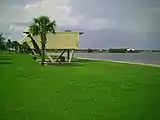 |
| Fairview-Riverside State Park | St. Tammany Parish | 98 acres (40 ha)[17] | 1962[18] | The Otis house, listed on the National Register of Historic Places, is located in the park.[18] |  |
| Fontainebleau State Park | St. Tammany Parish | 2,800 acres (1,133 ha)[19] | 1942[20] | The park was once the site of a sugar plantation and brick yard operated by Bernard de Marigny.[19] |  |
| Grand Isle State Park | Jefferson Parish | 140 acres (57 ha)[21] | 1968[22][23] | Grand Isle State Park is the only state-owned and -operated beach on the Louisiana gulf coast.[24] | 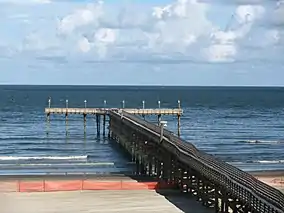 |
| Jimmie Davis State Park | Jackson Parish | 294 acres (119 ha)[25] | 1996[26] | Many of the largest bass caught in Louisiana have been in Caney Lake Reservoir which is in the park.[27] As of 2010, the largest bass from Louisiana was caught at Caney Lake.[28] | 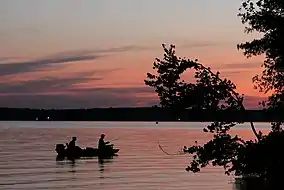 |
| Lake Bistineau State Park | Webster Parish | 750 acres (304 ha)[29][13] | 1938[30] | Lake Bistineau State Park is the first state park in Louisiana to accommodate African Americans, starting in 1956. The two separated areas are an artifact of the segregated nature of the park at the time.[31] |  |
| Lake Bruin State Park | Tensas Parish | 53 acres (21 ha)[32] | 1956[33] | Lake Bruin State Park was originally established in 1928 as a fish hatchery.[34] |  A shaded area next to a small pier |
| Lake Claiborne State Park | Claiborne Parish | 643 acres (260 ha)[35] | 1974[36] | Lake Claiborne State Park is situated on, but does not include, Lake Claiborne, the park's main attraction. When at full reservoir level, Lake Claiborne has a surface area of 6,400 acres (2,590 ha).[37] | 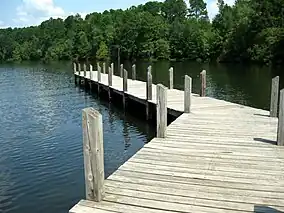 |
| Lake D'Arbonne State Park | Union Parish | 655 acres (265 ha)[38] | 1967[39] | Lake D'Arbonne State Park offers disc golf. The course is located near the group camp.[38] |  |
| Lake Fausse Pointe State Park | Iberia and St. Martin parishes | 6,000 acres (2,428 ha)[40] | 1987[7] | The site was once part of the Atchafalaya Basin and the surrounding land was once the home of the Chitimacha Native Americans.[40] | 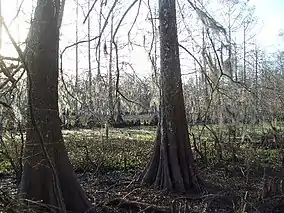 |
| North Toledo Bend State Park | Sabine Parish | 900 acres (364 ha)[41][42] | 1987[43] | The park is situated on Toledo Bend Reservoir,[41] the 5th largest in the nation by surface area.[44] |  |
| Palmetto Island State Park | Vermilion Parish | 1,299 acres (526 ha)[45] | 2010[45] | The visitor center complex contains a water playground and a bathhouse.[46] | 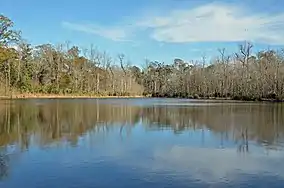 |
| Poverty Point Reservoir State Park | Richland Parish | 2,700 acres (1,093 ha)[47] | 2005[48] | Due to an active bear population, bear-proof containers are provided for waste disposal throughout the park.[49] |  |
| St. Bernard State Park | St. Bernard Parish | 358 acres (145 ha)[50] | 1971[51] | A local family business donated the land for the park to Louisiana in 1971.[51] |  |
| Sam Houston Jones State Park | Calcasieu Parish | 1,087 acres (440 ha)[52] | 1944[12] | The park is located north of the most productive birding region of Louisiana. At certain times of year, nearly 200 species of birds can be seen within 30 miles (48 km) of the park.[52] | 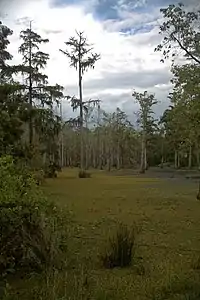 |
| South Toledo Bend State Park | Vernon Parish | 1,000 acres (405 ha)[53][54] | 2004[54] | South Toledo Bend State Park is a nesting ground for the bald eagle, which feeds from the supply of freshwater fish, including largemouth bass, catfish, bream, and white perch.[54] |  |
| Tickfaw State Park | Livingston Parish | 1,200 acres (486 ha)[55] | 1999[55] | Tickfaw State Park contains four distinct ecosystems: a cypress/tupelo swamp, a bottomland hardwood forest, a mixed pine/hardwood forest,[56] and the Tickfaw River. |  |
Other names of current parks
The following are significantly different former or alternate names for current Louisiana state parks.
| Former or alternate name | Parish | Current park name | Remarks |
|---|---|---|---|
| Caney Creek Lake State Park | Jackson Parish | Jimmie Davis State Park | The park is located on Caney Lake Reservoir, which was created by damming Caney Creek in 1986.[26] It was renamed in 2003.[26] |
| Lake Bruin Wayside Park | Tensas Parish | Lake Bruin State Park | Originally only a park, but when made a state park it was renamed in 1962. |
| Sam Houston State Park | Calcasieu Parish | Sam Houston Jones State Park | Originally named for Sam Houston, but was renamed in honor of Sam Houston Jones, 46th Governor of Louisiana.[52] |
| Tchefuncte State Park and Conservation Reservation | St. Tammany Parish | Fontainebleau State Park | The land was originally owned by Bernard de Marigny who called the area Fontainebleau after a forest in Paris he admired.[20] When designated a state park, Governor Richard W. Leche named it Tchefuncte State Park and Conservation Reservation, which was later reverted to Fontainebleau. |
Former state parks
The following are parks that were officially recognized as a state park after the 1966 National Park Service review, but were later removed.
| Park name | Parish | Size | Date Established | Date Removed | Remarks | Image |
|---|---|---|---|---|---|---|
| Hodges Gardens State Park | Sabine Parish | 700 acres (283 ha)[57] | 1956[57] | October 1, 2017[58] | The park features a 225-acre man-made lake that was built in 1954.[57] After a funding issue, the donated property was reverted to the A.J. and Nona Triggs Hodges Foundation.[58] | 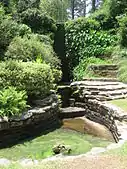 |
See also
References
- Smith, Darren L. (May 30, 2007). Gill, Kay (ed.). Parks Directory of the United States (5 ed.). Omnigraphics, Inc. ISBN 978-0-7808-0018-2.
- Herndon, Ernest (April 15, 2003). Canoeing Louisiana. University Press of Mississippi. ISBN 978-1-57806-426-7.
- ↑ "Louisiana State Parks". Louisiana Department of Culture, Recreation and Tourism. 2011. Retrieved March 21, 2011.
- 1 2 3 4 5 6 Historical Overview of LA State Parks System. Louisiana Department of Culture, Recreation and Tourism. 2009.
- 1 2 Louisiana State Parks Plan, 1975-1990–Master Plan for Improvements to the State Parks System. Gulf South Research Institute. 1973.
- ↑ State of Louisiana comprehensive outdoor recreation plan–1970-1975. Louisiana State Parks and Recreation Commission. 1971.
- 1 2 3 "Chemin-A-Haut State Park". Office of State Parks, Department of Culture Recreation and Tourism. Retrieved February 7, 2022.
- ↑ Gorman, Carolyn Portier; Schultz, Deborah. Barataria-Terrebonne National Estuary Program–Tour Guide. p. 20. Archived from the original (pdf) on August 12, 2011. Retrieved March 18, 2011.
- 1 2 Louisiana Conservationist. Vol. 40–42. Louisiana Wild Life and Fisheries Commission, Louisiana. Dept. of Wildlife and Fisheries. 1988.
Bayou Segnette State Park in Jefferson Parish and Lake Fausse Pointe State Park in Iberia Parish since the grand opening in 1987 have been very popular.
- ↑ "Bayou Segnette State Park". Office of State Parks, Department of Culture Recreation and Tourism. Retrieved February 7, 2022.
- 1 2 "Bogue Chitto State Park". Office of State Parks, Department of Culture Recreation and Tourism. Retrieved February 7, 2022.
- ↑ Derry, Jim (August 4, 2010). "Bogue Chitto State Park near Franklinton set to open at the end of this month". The Times-Picayune. New Orleans, Louisiana: Advance Publications. Archived from the original on June 29, 2011. Retrieved February 14, 2011.
- ↑ Baca, Keith (June 1, 2007). Native American place names in Mississippi. University Press of Mississippi. p. 10. ISBN 978-1-57806-955-2.
- 1 2 3 2009 Wall Calendar–75 Years of Celebrating Louisiana's Treasures and Making Memories. Office of State Parks, Department of Culture Recreation and Tourism. 2009.
- 1 2 3 "Louisiana State Parks Brochure" (PDF). Louisiana State Parks. Retrieved July 21, 2017.
- 1 2 "Chicot State Park". Office of State Parks, Department of Culture Recreation and Tourism. Retrieved February 7, 2022.
- 1 2 "Cypremort Point State Park". Office of State Parks, Department of Culture Recreation and Tourism. Retrieved February 7, 2022.
- ↑ "Weekend with Nick". January 19, 2009. Retrieved April 23, 2012.
- ↑ DeHaan, Vici (April 1996). State Parks of the South: America's Historic Paradise : A Guide to Camping, Fishing, Hiking, & Sightseeing. Johnson Books. p. 192. ISBN 978-1-55566-167-0.
- 1 2 "Fairview-Riverside State Park". Office of State Parks, Department of Culture Recreation and Tourism. Retrieved February 7, 2022.
- 1 2 "Fontainebleau State Park". Office of State Parks, Department of Culture Recreation and Tourism. Retrieved February 7, 2022.
- 1 2 Adams, Nixon (November 5, 2009). "Northshore Conifer–It Is What It Was". Northshore Conifer. Archived from the original on October 8, 2011. Retrieved March 18, 2011.
- ↑ Frois, Jeanne; Calhoun, Milburn (May 31, 2006). Louisiana Almanac: 2006-2007 (17 ed.). Pelican Publishing. p. 58. ISBN 978-1-58980-306-0.
- ↑ "Make a Weekend Stop to Grand Isle State Park". Houma, Louisiana: Gumbo Entertainment Guide. July 6, 2011. Retrieved April 11, 2012.
Nestled in the northeastern portion of the only inhabited barrier island in the state, Louisiana purchased the 150-acre park in 1968.
- ↑ "Facebook–Grand Isle State Park". Office of State Parks, Department of Culture Recreation and Tourism. Retrieved April 11, 2012.
The park was purchased in 1968 by the State.
- ↑ "Grand Isle Beach Reopens to Public". KTBS-TV. Associated Press. July 25, 2008. Retrieved November 5, 2017.
- ↑ Smith 2007, p. 499.
- 1 2 3 "Jimmie Davis State Park". Office of State Parks, Department of Culture Recreation and Tourism. Retrieved February 7, 2022.
- ↑ Felsher, John N. (May 2006). "The Changing Face Of Caney Lake". Game & Fish Magazine. Archived from the original on January 23, 2013. Retrieved April 1, 2011.
- ↑ Crawford, Andy (March 25, 2010). "16-pound bass caught on Caddo, Louisiana record at stake". Archived from the original on July 20, 2011. Retrieved April 1, 2011.
The current state record is a 15.97-pounder landed by Greg Wiggins in 1994 while fishing Caney Lake.
- ↑ Louisiana State Parks–A Guide to Louisiana's State Parks, State Historic Sites and Preservation Areas Brochure. Louisiana State Parks. 2007.
- ↑ "Lake Bistineau State Park". Office of State Parks, Department of Culture Recreation and Tourism. Archived from the original on March 5, 2005. Retrieved March 17, 2011.
- ↑ Otto, David (August 17, 2007). Insiders' Guide to Shreveport. Insiders' Guide. p. 127. ISBN 978-0-7627-5702-2.
- ↑ Fonseca, Mary (August 8, 1996). Weekend Getaways in Louisiana. Pelican Publishing. p. 188. ISBN 978-1-56554-096-5.
- ↑ "Wildernet.com–Lake Bruin State Park, Louisiana State Parks". Interactive Outdoors Inc. Retrieved April 18, 2012.
- ↑ "Lake Bruin State Park". Office of State Parks, Department of Culture Recreation and Tourism. Retrieved February 7, 2022.
- ↑ Herring, Susan. "Claiborne Parish Lakes and Recreation Areas". Archived from the original on December 11, 2010. Retrieved February 14, 2011.
- ↑ Outdoor Recreation Action. United States. Bureau of Outdoor Recreation. 1974. p. 67.
- ↑ "Lake Claiborne State Park". Office of State Parks, Department of Culture Recreation and Tourism. Retrieved February 7, 2022.
- 1 2 "Lake D'Arbonne State Park". Office of State Parks, Department of Culture Recreation and Tourism. Retrieved February 7, 2022.
- ↑ "Fall General Meeting at Lake D'Arbonne" (PDF). Pack & Paddle. Ozark Society (Summer): 7. June 2009. Archived from the original (PDF) on February 2, 2010. Retrieved March 31, 2012.
- 1 2 "Lake Fausse Pointe State Park". Office of State Parks, Department of Culture Recreation and Tourism. Retrieved February 7, 2022.
- 1 2 "North Toledo Bend State Park". Office of State Parks, Department of Culture Recreation and Tourism. Retrieved February 7, 2022.
- ↑ Louisiana State Parks Crossroads Brochure. Louisiana State Parks. 2007.
- ↑ Louisiana statewide comprehensive outdoor recreation plan: Information base for executive decision, 1993-1998. Vol. 1. Division of Outdoor Recreation. 1994.
North Toledo Bend State Park has been developed and has been operational since 1987.
- ↑ "North Toledo Bend (WMA)". Austin, Texas: Texas Parks and Wildlife Department. April 21, 2009. Retrieved June 13, 2011.
- 1 2 Bergeron, Judy (November 7, 2010). "Palmetto Island State Park opens in Abbeville". The Advocate. Baton Rouge, Louisiana. Archived from the original on January 27, 2011. Retrieved February 14, 2011.
- ↑ "Palmetto Island State Park". Office of State Parks, Department of Culture Recreation and Tourism. Retrieved February 7, 2022.
- ↑ Smith 2007, p. 502.
- ↑ "Poverty Point Reservoir" (PDF). Louisiana Department of Public Works and Water Resources.
- ↑ "Poverty Point Reservoir State Park". Office of State Parks, Department of Culture Recreation and Tourism. Retrieved February 7, 2022.
- ↑ Sternberg, Mary Ann. The Pelican Guide to Louisiana (2 ed.). Pelican Publishing Company Inc. p. 160. ISBN 978-0-88289-901-5.
- 1 2 "St. Bernard State Park". Office of State Parks, Department of Culture Recreation and Tourism. Retrieved February 7, 2022.
- 1 2 3 "Sam Houston State Park". Office of State Parks, Department of Culture Recreation and Tourism. Retrieved February 7, 2022.
- ↑ "South Toledo Bend State Park - Toledo Bend Lake". Retrieved February 7, 2022.
- 1 2 3 "South Toledo Bend State Park". Louisiana: Office of State Parks, Department of Culture Recreation and Tourism. Retrieved January 30, 2011.
- 1 2 Herndon 2003, p. 165.
- ↑ Gomez, Ms. Gay M. (October 9, 2008). The Louisiana Coast: Guide to an American Wetland. Texas A&M University-Corpus Christi. p. 161. ISBN 978-1-60344-033-2.
- 1 2 3 "Hodges Gardens State Park–Louisiana Office of State Parks". Office of State Parks, Department of Culture Recreation and Tourism. Archived from the original on April 6, 2014. Retrieved January 30, 2011.
- 1 2 Guidry, Leigh. "Hodges Gardens State Park a 'casualty of the funding crisis;' control reverts to foundation". The Daily Advertiser. Retrieved February 7, 2018.